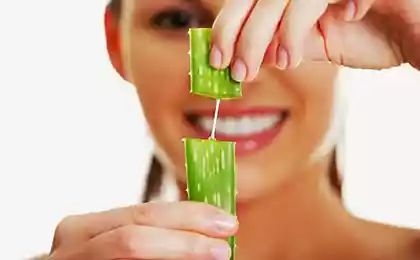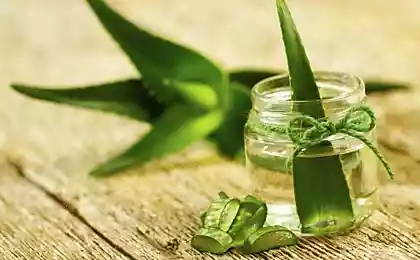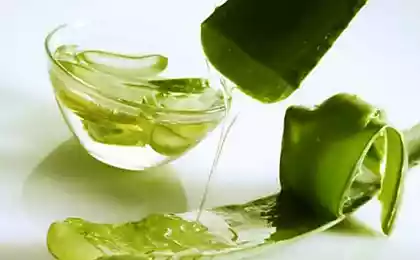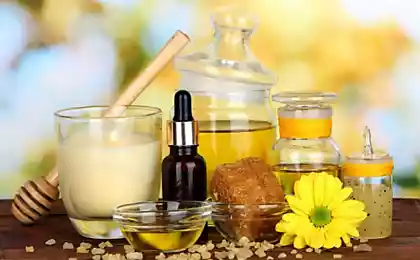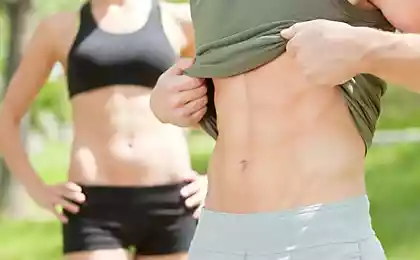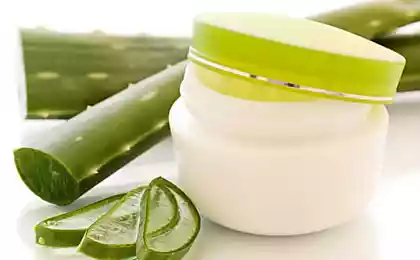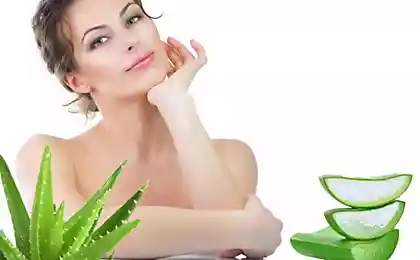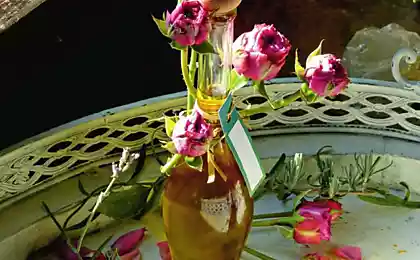762
Reveal the SECRETS of RemoveAny: your individual best makeup!
Most of us constantly use the creams without thinking about what it is and why cream brings to our faces (and bodies), favor (rarely damages).
What is this cream?
In fact, the cream is an emulsion, which is formed by mixing the fat (butter) and water. Fat water just don't mix. Therefore, to get the texture of the emulsion, for the production of cream is of the desired emulsifier.
In fact, oil + emulsifier + water = cream.
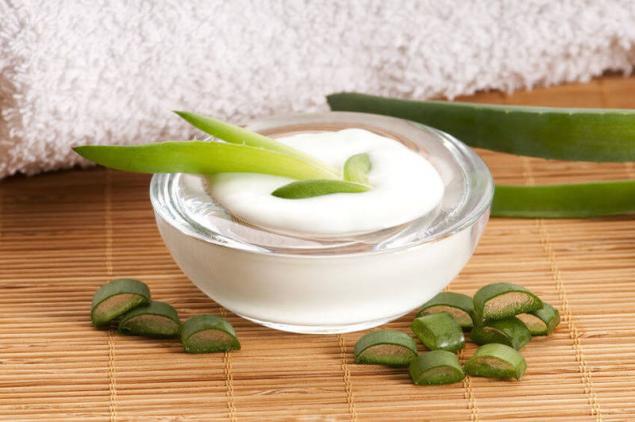
For some miraculous reason you decided to makethe cream yourself.
Recipes, found on the network, type "grate banana, mix it with cottage cheese, add honey and cream, mix all and shake as received a creamy mass of a chicken egg yolk" for some reason you are not satisfied.
The fact that the Internet is "one woman told", describing similar recipes "from grandma's chest", is actually creams is not. This masks, and disposable, because they are very perishable.
Natural cream, brewed at home, the consistency is generally exactly the same as the store, only the best composition.
In General, removerange existed a long time ago. They also say that in excavations of Ancient Egypt have found a miracle survivor and extant capacity with cream, moreover, their composition is not much different from the modern one. Believe it or not — you decide.
But in the XVIII-XIX-XX centuries the cream is cooked in full.
So. To prepare the cream, we need:
Butter is better to take the first extraction. If you do not now have a wide range of oils (grape, macadamia, Shea (Shea butter), mango, coconut, cotton, jojoba and others, which you are sure will eventually get when removerange will delay you in earnest), can for the first cream to take regular sunflower or olive oil.
Suppose you have now no emulsifier. In that case, go to market, find the counter where they sell honey and buy it some wax. The wax is sold not only in the market, but also in specialty stores or departments where they sell bee products. Beeswax is also an emulsifier. However, he simultaneously performs the function of a preservative. Someone he would fit perfectly for someone's skin seem heavy. If you're reading this in winter, most likely, the wax will be very handy. In the summer the cream wax to add is not necessary.
Or locate a store or Department that sells dietary Supplements (biologically active additives), and ask there lecithin. It is better to take granular. But the first case can be purchased in capsules. However, keep in mind that the cream, made on the lecithin, should be used for 1-2 months. More he will not stand, despite the fact that it will be stored in the refrigerator.
In the most extreme cases, will have to make the cream with chicken or quail egg yolk. But this is not quite a cream, and something like those recipes where you mix claw unicorn with purple skin of a frog. And stored this cream will be the strength of the week. Of course, to live all this time he will also be in the fridge.
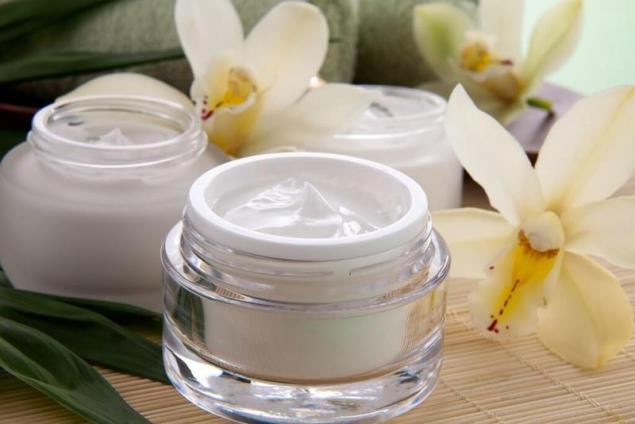
So, you already have: butter, emulsifier and water. Start!
Electronic scales you probably also yet? Will survive. But the thermometer, better yet, to purchase in advance.
Suppose we decided to make a fairly thick cream — or winter night. In this case, the ratio of oil and water should be 60/40 or 50/50. For lighter creams the ratio of fat to water is 30/70, or, if you dare, 25/75. But the experiment you will be late. While preparing a dense nutritious cream.
Wax dissolves in oil. Lecithin is dissolved in water, and it (we make 50 ml of cream), as well as any of the emulsifier should be about 5%, i.e., in this case is 2.5 ml So it was all quite accurate, take a 5-CC syringe, cut off the tip and add to it 2.5 ml of lecithin. Then you can pour it into a spoon in the future to know how much emulsifier you need. After that, pour it in a container and cover with water, let it swell for about 15-20 minutes. After 20 minutes, when you start to boil the cream, pour the contents of this container in a jar of water. When you have other emulsifiers, read their descriptions, from which you will learn where and how to dissolve the specific emulsifier.
If you managed to measure the scale of oil and water — excellent. If not — take a tablespoon. This spoon pour in a jar 3 tablespoons of water (mineral, spring or store, for example, for baby food). Here you will pour the lecithin, which is already quite swollen. 1-2 tablespoons (depending on how much cream you're going to get) into another jar. The water you heat will not, it will remain cold.
In another jar with the same spoon, measure and pour 5-6 spoons of oil (one or 2-3 tablespoons two to three oils). If you are cooking the cream on the wax, this also put wax (a few pieces the size of a pea).
In kremovatym these two jars with oil and water — called phase – aqueous phase (VF) and fat phase (ZHF).
A little more detail on the phases.
THE AQUEOUS PHASE
— it may be just an ordinary pure water — not tap, spring or in-store.
or the aqueous phase will consist of floral water, hydrolate or Hydrosol (the three names for the same thing).
— can be mineral water.
— you can make the cream with distilled water.
— you can take a tea (it is well-tones the skin), decoctions of herbs etc. (though these creams have a shelf life shorter).
FATTY PHASE
— Vegetable oil – a base oil (grape, peach, apricot, macadamia, cocoa, jojoba, wheat germ, almonds, avocados, cotton, hemp, etc.). Butter yellow along the way have a, albeit small, protective effect.
sometimes for creams, especially in winter, use a animal fat – butter (melted, or ghee) – preferably from a cow, butter from the market, or chicken fat. This cream is more dense in consistency, and very well behaved on her face. However, he still retains a little odour of animal fat.
In future nobody will ever be able to recommend to you the "correct oil. Oil for the cream, you can choose only one way — by experience. Only your skin will tell you what oil is right for you. No matter how criticized olive oil for having "forms comedones", I personally know people with perfectly nourished skin, which is only one oil from all in the Universe — you guessed it — olive. I love grapeseed oil. Cocoa butter, which many praise, and so I bought it in bulk a whole litre — I did not like it. And you might like it, take 100 grams, check for yourself. I love cannabis. In General, the choice of oil is yours, and only your business.
EMULSIFIER
— Wheat emulsifying wax (aka wheat emulsifier, xylans) — a natural emulsifier, which is produced from wheat bran. It's flawless – it is practically impossible to spoil the cream color is always pure white. The texture of the cream is pretty solid.
- Olivem 1000 — natural emulsifier from olive oil. Fatty acids included in the composition of this emulsifier are similar to the fatty layer of the skin.
— Planta-M — good for beginners and "advanced" removerow. The only negative about it everywhere write that it is completely of plant origin, but found no information about what is included with this emulsifier.
— Prolipid 141 — about it also write that it is "green", ie, entirely of plant origin, but also in the descriptions do not specify the composition of these plants. On Polypide is a light, pleasant texture of the cream.
There are good components on the oats, the flax, they work tactfully, without destroying the skin, but with them deep into the well to penetrate the skin nutrients.
Emulsifier in the cream should be not more than 5% of the total.
Emulsifiers not only the emulsification of oil and water. They have another problem — they're pushing a lipid (fat) layer of the skin (destroying it), the cream has penetrated further into the skin. Bad, aggressive emulsifiers pushing mamillary layer, destroy the skin. Recently in the network there are reports that, for example, Hollywood stars decomposes the skin. This is just a consequence of the use of harsh emulsifiers in creams instant action. This aggressive property of emulgatorov based creams instant action.
So, you put jars of water and oil in a bucket of water (for water bath), ladle on the stove, and heated the liquid to 70 degrees, stirring constantly (I do this with a wooden stick to sushi) is the phase where soluble emulsifier. Heated to 70 degrees jars remove from heat.
Thus, the process PRESERVES the cream takes about 3 minutes, maybe 5.

Take out jars from the bucket. Pour the water phase into fatty.
Your cream slowly cools down...
But this time...
The fun begins! Now, in the cooling cream, when the hand was easily kept in a jar, you can add assets. Remember, we left a jar into which I poured 1-2 tablespoons of water? Now it's her time!
ASSETS
— Essential oil (in a cream simply irreplaceable: rose, cucumber, carrot, saffron, evening primrose, nutmeg, good for the face of ginger, as well as you can choose any other oil to your taste. My daughter really like vanilla.
— Peptides are organic substances that consist of amino acid residues and work at the cellular level — start processes of recovery and regeneration of cells. Peptides, however, it is not necessary to add to creams for young skin.
— Hyaluronic acid — better, of course, is considered to be of low molecular weight. However, in Russian the Internet-shops you can buy only high molecular hyaluronic. Although, in fairness, it may be noted that in this form it behaves very nicely on the skin. It must be the cream quite a bit. Before adding it to the cream, it should be diluted in water (at the tip of the knife into 30 ml of water) for 8 hours and refrigerate. In 8 hours it will turn into something gel-like. This mass can already be added to the cream. It can be directly add to Water Phase and heat on a water bath.
— Aloe Vera — it can be used in different forms: gel, oil, liquid concentrate from the pharmacy vials. Aloe Vera soothes, refreshes, tones the skin. It can be used for skin of any age.
— Vitamins. For face good vitamins of group B. Vitamin C can only be added to a night cream, because the skin reaction, saturated with vitamin C a day, can be unpredictable, up to the appearance of age spots. Vitamin a is wonderful for the skin, but creams with vitamin a will certainly need to store in the refrigerator.
You can also experiment with any other assets of extracts, pharmaceutical agents, for example, Ginko biloba, or any other, useful for the skin.
Add the cream cold phase, mix. And finally — the cream needs a preservative.
PRESERVATIVES
Of course, I wanted to write "natural preservatives", but alas, not always it'll be to use only natural preservatives. If the cream will be stored in the refrigerator, you will take it only with a clean spoon, and you have made a small portion of the cream, then really you can do a natural preservative.
— Wax, mentioned above, preserves the cream. But wax is not suitable for summer creams.
— Honey is also a preservative, however, is not very strong preservative.
— Salt on the tip of a knife for a while will help to preserve the cream.
— Vitamin E is a preservative. It 50 ml of 5-8 drops is sufficient.
— Malavit — pharmaceutical preparation is also a cream preservative, however, as in the previous cases, you should try to use the cream as quickly as possible.
— Citrosept (extract greipfrutik bones). anti-cold medication — is more reliable preservative.
— Some essential oils have antiseptic, antimicrobial action, are also preservatives. You just have to choose any scent, since essential oils with similar effects, often have a rather sharp and aggressive smell.
— Some plant extracts, containing natural sodium benzoate (for example, cranberry or Apple).
— If you need the cream more shelf stable, or are you going to take your cream on a journey without this preservative should be provided. In this case, try to use foodsthat can be purchased in supermarkets, departments for canning. For example, sodium benzoate (aka E211). However, he in any case should not be where you added vitamin C, because in combination with ascorbic acid it turns into benzene, which is a potent carcinogen that causes skin cancer. It is unlikely that other chemical conservatives better than this. For example, potassium sorbate (E202) frequently causes an allergic reaction.
In General, the issue of using chemical preservatives for me personally is still open.
Adding cold phase with assets dropping a few drops of natural preservatives or pour chemical preservatives (of course, pre-dissolved) and again mix the cream, put it in the fridge (even the freezer) for 15-20 minutes. Then take it out and stir again. Repeat the stirring need to as long as the emulsion will not be stable — it 3-4-5 times.
And your cream is ready!

However, we must remember that the skin quickly gets used to the assets. That is why in a past life you often had to change creams. Why not try in one cream to add all the assets, herbal teas, aroma oils, which only comes to mind. Face cream — this is not an encyclopedia. In one cream, according to the classics, it is desirable to use from 3 to 5 assets (including, hydrolat, the actual assets and essential oils. The next cream you have every right to do with a completely different composition.
Because now you learned how to make cream, and you do not need to add all the assets to your new cream.
Otherwise, having zaviduschie eyes and hands, you risk to accustom your skin to all the assets together, at once, and in a few months, stay with the skin, insensitive to any stimuli.
And finally. NEVER add cream to industrial oils. Some believe that the cream boil hard or impossible, but to "enrich" industrial cream with aromatic oils. No, it's not.
Aroma oils are highly potent drugs (in fact, the essential oil is poison, and in cooperation with the it all depends on the dosage). Possessing a high ability to penetrate deep into the skin, essential oils not only penetrate it, but also holds other assets.
In industrial creams are always a lot of preservatives, thickeners, and other things that were not originally intended for penetration in the deeper layers of your skin. Fragrance oil, which you "enriched" industrial cream, these malicious substances gives the green light.
So, if you removerange seems complicated, better "mix the banana with honey and add to the yolk paste" than it is to add essential oil to the industrial cream!
And now comes the moment that should really make You happy.
If there had been significant errors in the preparatory stages, You will get the immediate feeling of success. When preparing cold (i.e. cold) cream or milk, pre-mixed oily and the aqueous phase is poured into the end vessel (tube or pipette), then add water-soluble active substances and, if necessary, a preservative. All the contents are thoroughly shaken until a homogeneous emulsion. The cream is ready for use.
If You're serving hot cream (creamy hot), here we offer You two ways of cooking to choose from.
The simplest method is the following:
Temperature boiled water phase in this case, usually enough to melt the cooled oily phase.
After the Bay of the aqueous phase slightly stir the fat in the Cup, so he took a liquid form. And then either with a whisk or spoon for eggs, or special automatic mini mixer well stir the cream until until its temperature drops to body temperature (the temperature of hands).
You can speed up the cooling process of the cream, placing the Cup in a saucepan of cold water. It is necessary to constantly stir the emulsion. Mixing components can take a good shaking both phases in a closed vessel. You can also use the tub with cold water for faster cooling – only from time to time by placing it in a vessel.
The second method is a classic:
Importantly, the fat in the fat phase is completely melt. Then you can add fat-soluble components, such as vitamin E.
Thoroughly mix the fatty phase and quickly pour the hot water phase. Then mix all into a homogeneous emulsion described in the first method, method.
Also interesting: Winter face masks: top 8 recipes
How to prepare natural rejuvenating cream: 3 SUPER recipe
You will see for yourself that with such simple and easy ways, You wonít be able to imagine my life without individual cosmetics.published
Source: duhosin.ru/sekretyi-kremovareniya/
What is this cream?
In fact, the cream is an emulsion, which is formed by mixing the fat (butter) and water. Fat water just don't mix. Therefore, to get the texture of the emulsion, for the production of cream is of the desired emulsifier.
In fact, oil + emulsifier + water = cream.

For some miraculous reason you decided to makethe cream yourself.
Recipes, found on the network, type "grate banana, mix it with cottage cheese, add honey and cream, mix all and shake as received a creamy mass of a chicken egg yolk" for some reason you are not satisfied.
The fact that the Internet is "one woman told", describing similar recipes "from grandma's chest", is actually creams is not. This masks, and disposable, because they are very perishable.
Natural cream, brewed at home, the consistency is generally exactly the same as the store, only the best composition.
In General, removerange existed a long time ago. They also say that in excavations of Ancient Egypt have found a miracle survivor and extant capacity with cream, moreover, their composition is not much different from the modern one. Believe it or not — you decide.
But in the XVIII-XIX-XX centuries the cream is cooked in full.
So. To prepare the cream, we need:
- oil
- emulsifier,
- water,
- shallow the ladle,
- 2-3 glass jars (you can get jars from baby food).
Butter is better to take the first extraction. If you do not now have a wide range of oils (grape, macadamia, Shea (Shea butter), mango, coconut, cotton, jojoba and others, which you are sure will eventually get when removerange will delay you in earnest), can for the first cream to take regular sunflower or olive oil.
Suppose you have now no emulsifier. In that case, go to market, find the counter where they sell honey and buy it some wax. The wax is sold not only in the market, but also in specialty stores or departments where they sell bee products. Beeswax is also an emulsifier. However, he simultaneously performs the function of a preservative. Someone he would fit perfectly for someone's skin seem heavy. If you're reading this in winter, most likely, the wax will be very handy. In the summer the cream wax to add is not necessary.
Or locate a store or Department that sells dietary Supplements (biologically active additives), and ask there lecithin. It is better to take granular. But the first case can be purchased in capsules. However, keep in mind that the cream, made on the lecithin, should be used for 1-2 months. More he will not stand, despite the fact that it will be stored in the refrigerator.
In the most extreme cases, will have to make the cream with chicken or quail egg yolk. But this is not quite a cream, and something like those recipes where you mix claw unicorn with purple skin of a frog. And stored this cream will be the strength of the week. Of course, to live all this time he will also be in the fridge.

So, you already have: butter, emulsifier and water. Start!
Electronic scales you probably also yet? Will survive. But the thermometer, better yet, to purchase in advance.
Suppose we decided to make a fairly thick cream — or winter night. In this case, the ratio of oil and water should be 60/40 or 50/50. For lighter creams the ratio of fat to water is 30/70, or, if you dare, 25/75. But the experiment you will be late. While preparing a dense nutritious cream.
Wax dissolves in oil. Lecithin is dissolved in water, and it (we make 50 ml of cream), as well as any of the emulsifier should be about 5%, i.e., in this case is 2.5 ml So it was all quite accurate, take a 5-CC syringe, cut off the tip and add to it 2.5 ml of lecithin. Then you can pour it into a spoon in the future to know how much emulsifier you need. After that, pour it in a container and cover with water, let it swell for about 15-20 minutes. After 20 minutes, when you start to boil the cream, pour the contents of this container in a jar of water. When you have other emulsifiers, read their descriptions, from which you will learn where and how to dissolve the specific emulsifier.
If you managed to measure the scale of oil and water — excellent. If not — take a tablespoon. This spoon pour in a jar 3 tablespoons of water (mineral, spring or store, for example, for baby food). Here you will pour the lecithin, which is already quite swollen. 1-2 tablespoons (depending on how much cream you're going to get) into another jar. The water you heat will not, it will remain cold.
In another jar with the same spoon, measure and pour 5-6 spoons of oil (one or 2-3 tablespoons two to three oils). If you are cooking the cream on the wax, this also put wax (a few pieces the size of a pea).
In kremovatym these two jars with oil and water — called phase – aqueous phase (VF) and fat phase (ZHF).
A little more detail on the phases.
THE AQUEOUS PHASE
— it may be just an ordinary pure water — not tap, spring or in-store.
or the aqueous phase will consist of floral water, hydrolate or Hydrosol (the three names for the same thing).
— can be mineral water.
— you can make the cream with distilled water.
— you can take a tea (it is well-tones the skin), decoctions of herbs etc. (though these creams have a shelf life shorter).
FATTY PHASE
— Vegetable oil – a base oil (grape, peach, apricot, macadamia, cocoa, jojoba, wheat germ, almonds, avocados, cotton, hemp, etc.). Butter yellow along the way have a, albeit small, protective effect.
sometimes for creams, especially in winter, use a animal fat – butter (melted, or ghee) – preferably from a cow, butter from the market, or chicken fat. This cream is more dense in consistency, and very well behaved on her face. However, he still retains a little odour of animal fat.
In future nobody will ever be able to recommend to you the "correct oil. Oil for the cream, you can choose only one way — by experience. Only your skin will tell you what oil is right for you. No matter how criticized olive oil for having "forms comedones", I personally know people with perfectly nourished skin, which is only one oil from all in the Universe — you guessed it — olive. I love grapeseed oil. Cocoa butter, which many praise, and so I bought it in bulk a whole litre — I did not like it. And you might like it, take 100 grams, check for yourself. I love cannabis. In General, the choice of oil is yours, and only your business.
EMULSIFIER
— Wheat emulsifying wax (aka wheat emulsifier, xylans) — a natural emulsifier, which is produced from wheat bran. It's flawless – it is practically impossible to spoil the cream color is always pure white. The texture of the cream is pretty solid.
- Olivem 1000 — natural emulsifier from olive oil. Fatty acids included in the composition of this emulsifier are similar to the fatty layer of the skin.
— Planta-M — good for beginners and "advanced" removerow. The only negative about it everywhere write that it is completely of plant origin, but found no information about what is included with this emulsifier.
— Prolipid 141 — about it also write that it is "green", ie, entirely of plant origin, but also in the descriptions do not specify the composition of these plants. On Polypide is a light, pleasant texture of the cream.
There are good components on the oats, the flax, they work tactfully, without destroying the skin, but with them deep into the well to penetrate the skin nutrients.
Emulsifier in the cream should be not more than 5% of the total.
Emulsifiers not only the emulsification of oil and water. They have another problem — they're pushing a lipid (fat) layer of the skin (destroying it), the cream has penetrated further into the skin. Bad, aggressive emulsifiers pushing mamillary layer, destroy the skin. Recently in the network there are reports that, for example, Hollywood stars decomposes the skin. This is just a consequence of the use of harsh emulsifiers in creams instant action. This aggressive property of emulgatorov based creams instant action.
So, you put jars of water and oil in a bucket of water (for water bath), ladle on the stove, and heated the liquid to 70 degrees, stirring constantly (I do this with a wooden stick to sushi) is the phase where soluble emulsifier. Heated to 70 degrees jars remove from heat.
Thus, the process PRESERVES the cream takes about 3 minutes, maybe 5.

Take out jars from the bucket. Pour the water phase into fatty.
Your cream slowly cools down...
But this time...
The fun begins! Now, in the cooling cream, when the hand was easily kept in a jar, you can add assets. Remember, we left a jar into which I poured 1-2 tablespoons of water? Now it's her time!
ASSETS
— Essential oil (in a cream simply irreplaceable: rose, cucumber, carrot, saffron, evening primrose, nutmeg, good for the face of ginger, as well as you can choose any other oil to your taste. My daughter really like vanilla.
— Peptides are organic substances that consist of amino acid residues and work at the cellular level — start processes of recovery and regeneration of cells. Peptides, however, it is not necessary to add to creams for young skin.
— Hyaluronic acid — better, of course, is considered to be of low molecular weight. However, in Russian the Internet-shops you can buy only high molecular hyaluronic. Although, in fairness, it may be noted that in this form it behaves very nicely on the skin. It must be the cream quite a bit. Before adding it to the cream, it should be diluted in water (at the tip of the knife into 30 ml of water) for 8 hours and refrigerate. In 8 hours it will turn into something gel-like. This mass can already be added to the cream. It can be directly add to Water Phase and heat on a water bath.
— Aloe Vera — it can be used in different forms: gel, oil, liquid concentrate from the pharmacy vials. Aloe Vera soothes, refreshes, tones the skin. It can be used for skin of any age.
— Vitamins. For face good vitamins of group B. Vitamin C can only be added to a night cream, because the skin reaction, saturated with vitamin C a day, can be unpredictable, up to the appearance of age spots. Vitamin a is wonderful for the skin, but creams with vitamin a will certainly need to store in the refrigerator.
You can also experiment with any other assets of extracts, pharmaceutical agents, for example, Ginko biloba, or any other, useful for the skin.
Add the cream cold phase, mix. And finally — the cream needs a preservative.
PRESERVATIVES
Of course, I wanted to write "natural preservatives", but alas, not always it'll be to use only natural preservatives. If the cream will be stored in the refrigerator, you will take it only with a clean spoon, and you have made a small portion of the cream, then really you can do a natural preservative.
— Wax, mentioned above, preserves the cream. But wax is not suitable for summer creams.
— Honey is also a preservative, however, is not very strong preservative.
— Salt on the tip of a knife for a while will help to preserve the cream.
— Vitamin E is a preservative. It 50 ml of 5-8 drops is sufficient.
— Malavit — pharmaceutical preparation is also a cream preservative, however, as in the previous cases, you should try to use the cream as quickly as possible.
— Citrosept (extract greipfrutik bones). anti-cold medication — is more reliable preservative.
— Some essential oils have antiseptic, antimicrobial action, are also preservatives. You just have to choose any scent, since essential oils with similar effects, often have a rather sharp and aggressive smell.
— Some plant extracts, containing natural sodium benzoate (for example, cranberry or Apple).
— If you need the cream more shelf stable, or are you going to take your cream on a journey without this preservative should be provided. In this case, try to use foodsthat can be purchased in supermarkets, departments for canning. For example, sodium benzoate (aka E211). However, he in any case should not be where you added vitamin C, because in combination with ascorbic acid it turns into benzene, which is a potent carcinogen that causes skin cancer. It is unlikely that other chemical conservatives better than this. For example, potassium sorbate (E202) frequently causes an allergic reaction.
In General, the issue of using chemical preservatives for me personally is still open.
Adding cold phase with assets dropping a few drops of natural preservatives or pour chemical preservatives (of course, pre-dissolved) and again mix the cream, put it in the fridge (even the freezer) for 15-20 minutes. Then take it out and stir again. Repeat the stirring need to as long as the emulsion will not be stable — it 3-4-5 times.
And your cream is ready!

However, we must remember that the skin quickly gets used to the assets. That is why in a past life you often had to change creams. Why not try in one cream to add all the assets, herbal teas, aroma oils, which only comes to mind. Face cream — this is not an encyclopedia. In one cream, according to the classics, it is desirable to use from 3 to 5 assets (including, hydrolat, the actual assets and essential oils. The next cream you have every right to do with a completely different composition.
Because now you learned how to make cream, and you do not need to add all the assets to your new cream.
Otherwise, having zaviduschie eyes and hands, you risk to accustom your skin to all the assets together, at once, and in a few months, stay with the skin, insensitive to any stimuli.
And finally. NEVER add cream to industrial oils. Some believe that the cream boil hard or impossible, but to "enrich" industrial cream with aromatic oils. No, it's not.
Aroma oils are highly potent drugs (in fact, the essential oil is poison, and in cooperation with the it all depends on the dosage). Possessing a high ability to penetrate deep into the skin, essential oils not only penetrate it, but also holds other assets.
In industrial creams are always a lot of preservatives, thickeners, and other things that were not originally intended for penetration in the deeper layers of your skin. Fragrance oil, which you "enriched" industrial cream, these malicious substances gives the green light.
So, if you removerange seems complicated, better "mix the banana with honey and add to the yolk paste" than it is to add essential oil to the industrial cream!
And now comes the moment that should really make You happy.
If there had been significant errors in the preparatory stages, You will get the immediate feeling of success. When preparing cold (i.e. cold) cream or milk, pre-mixed oily and the aqueous phase is poured into the end vessel (tube or pipette), then add water-soluble active substances and, if necessary, a preservative. All the contents are thoroughly shaken until a homogeneous emulsion. The cream is ready for use.
If You're serving hot cream (creamy hot), here we offer You two ways of cooking to choose from.
The simplest method is the following:
- taken essential fatty phase is placed in a glass Cup, then this Cup is filled with hot (just after boiling) water phase. This method is suitable only for emulsions in which the ratio of water and fat is respectively 2:1 i.e. 2 parts water to 1 part fat.
Temperature boiled water phase in this case, usually enough to melt the cooled oily phase.
After the Bay of the aqueous phase slightly stir the fat in the Cup, so he took a liquid form. And then either with a whisk or spoon for eggs, or special automatic mini mixer well stir the cream until until its temperature drops to body temperature (the temperature of hands).
You can speed up the cooling process of the cream, placing the Cup in a saucepan of cold water. It is necessary to constantly stir the emulsion. Mixing components can take a good shaking both phases in a closed vessel. You can also use the tub with cold water for faster cooling – only from time to time by placing it in a vessel.
The second method is a classic:
- Oily and the aqueous phase is simultaneously heated in individual cups to a temperature of 65-70 °C. the exact temperature measurements there are needed: 5-10 degrees more or less – on what does not influence. You will gradually develop an intuitive sense of the right temperature.
Importantly, the fat in the fat phase is completely melt. Then you can add fat-soluble components, such as vitamin E.
Thoroughly mix the fatty phase and quickly pour the hot water phase. Then mix all into a homogeneous emulsion described in the first method, method.
Also interesting: Winter face masks: top 8 recipes
How to prepare natural rejuvenating cream: 3 SUPER recipe
You will see for yourself that with such simple and easy ways, You wonít be able to imagine my life without individual cosmetics.published
Source: duhosin.ru/sekretyi-kremovareniya/
Delicious pancakes of broccoli with Parmesan
9 interesting things to say about the health of your hands
